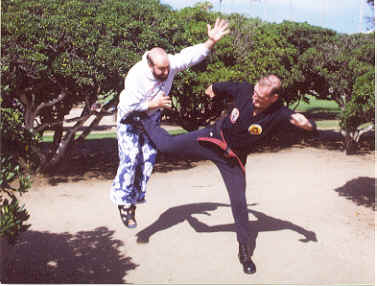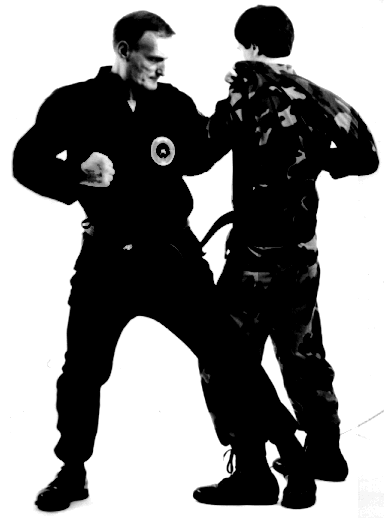
Grandmaster Gary Alexander has always been a get-on-the-mat-and-see-what-you-can-do kind of guy. Rugged and tough, this decorated Marine Corps veteran is the John Wayne of the martial arts world. In the late 1950's he began making a name for himself by beating the top karate stylists in bare-knuckle sparring matches. By taking on all comers, he helped his art become a repected form of unarmed combat; and by beating them to a pulp, he earned a reputation as the "hammer of isshin-ryu".
The Gary Alexander untold story is truly remarkable and it is a comeback saga of epic proportions. In the world of martial artists, Shihan Gary Alexander has been a force to be reckoned with for nearly four decades.
Grand Master Harold Long described him as "the Best Isshinryu Fighter that has ever been on the North American continent." Other accolades include Al Weiss’ comment in The Official History of Karate in America as "The best fighter in the country." For any martial artists such acknowledgements would require extensive training, skill and dedication. It might be assumed that such a fighter was always a natural athlete and had diligently exercised God-given physical prowess. In Alexander’s case, that assumption would be wrong-very wrong!Except for his family, few know that in his childhood Gary Alexander was literally bed-ridden for several years. He was the victim of rheumatic fever an acute disease that produces fever; causes pain to inflamed joints and frequently involves damage to the heart valves. Any movement whatsoever is painful and over-exertion or high levels of stress can have fatal consequences. Unlike most childhood diseases that are temporary annoyances at most, rheumatic fever preys on its victims for years. The long-term effects are extremely debilitating. Therefore, Alexander was deprived of participating in the normal sports activities enjoyed by boys of that era.

Grandmaster Gary Alexander executing powerful side kick
Instead of playing football, baseball, and basketball, he was obliged to stay in his home and play with his Lionel 027 gauge electric train set. School teachers came to the house and provide his lessons. Running and jumping were out of the question. In fact, he was so weak that for the few outings he was allowed to take, he had to be physically lifted and carried to the family car by his father. Against these long odds he struggled to preserver. Enduring the pain, Alexander exercised his joints developing and maintaining the necessary muscle tone to become ambulatory. Eventually, as the fever subsided, he had to develop the strength that others of his age had naturally attained years before. It required great effort to overcome these obstacles but in the process he learned lessons of perseverance that would become invaluable as he fought his way to the top of his profession.
Alexander had many surprises for his friends and family who knew him and his medical history. First, at only 17 years of age and still in high school, he amazed everyone by joining the US Marine Corps Reserve and spent his summers in military training. Upon graduation from high school he went on active duty and spent his third session at Paris Island completing Boot Camp.
Working his way up the enlisted chain he eventually rose to the rank of sergeant. His was not a desk job. Alexander joined the infantry and was part of the Fleet Marine Force, the Marine Corps element charged with amphibious assaults across hostile beaches. While in the Marines, Alexander was exposed to several forms of martial arts. Assigned in Okinawa, he first learned of the Isshinryu karate style that he would later adopt as his bedrock.Upon his return to the United States Alexander continued studying intently. By then the once sickly Alexander had developed extraordinary strength and the ability to attack both swiftly and powerfully.
In 1962, still in his early twenties, he went on to become a karate legend by becoming the first Karate Champion in the U.S. and North America. Since then Alexander has been a paragon of physical fitness and the epitome of courage and integrity. In martial arts, as in the Marines, he worked his way up the ranks the old-fashioned way-by earning it. Over the past four decades Alexander took on all comers. The old-timers will remember that these early matches were full-contact and without pads, a far cry from today’s fencing contests.These days, the, Edison, New Jersey-based Alexander is busier than ever teaching a modified version of isshin-ryu, which he simply refers to as "isshin-ryu plus." It is a hybrid system that just makes good sense; a solid foundation of original isshin-ryu upon which stands a unique blend of Alexander's own techniques and principles. I recently met Grandmaster Alexander at a tournament in West Palm Beach, Florida and was able to have a very nice chat with this great martial arts legend......

CK: Give our readers a brief background about yourself.
GMA: I am single, two grown boys, trained in the Martial Arts for several years and showed no further inclination beyond Brown Belt. I started training in Japan with some Judo, and some Karate in Okinawa. Only some because we didn’t have a bunch of time in our home Bases due to being on various manuevers most of the time. The bulk of my training came with a group of Marines that had trained up more so than myself and we huddled around Don Nagle as our main instructor in the beginning years-early 1960’s. My education consists of: B.A. Rutgers University, Dale Carnegie Programs, Multiple Sales/
CK:
What did you add to Isshin-ryu to create this "plus" system and how do you make it work?GMA: Being over 6’2'’ tall and endowed with broad shoulders, I can outreach many opponents and deliver knockout punches. Therefore, it made sense to him to incorporate moves that were foreign to Isshinryu.
I acknowledged the laws of physics, then, based on American physiology, applied them in the ring with devastating results. From a street perspective, I use what works for me. Like Lee before me, I incurred the wrath of many traditionalists of my style. For both of us, it was argued that centuries of evolution of our particular style should not be subjected to radical change. After all, how dare such upstarts alter traditions faithfully passed down from generation to generation by venerated masters who tolerated only the most modest changes. While firmly rooted in Isshinryu, I have continued the process of tailoring the style to meet the requirements of today. I evaluate the individual needs of each student then train them to their full potential. Success is often judged on the deeds of progeny. My black belt students are now spread around the world, many running their own dojos.Many people know about my accomplishments in martial arts. Very few know about the obstacles that I had to overcome to attain success.CK: What are some of the Hall of Fames you have been inducted in?
GMA: 1974 Black Belt Magazine Hall of Fame
1986 Tae Kwon Do Hall of Fame
1997 Australasian Martial Arts, Hall of Fame
2001 Action Martial Arts Magazine Hall of Fame
Many other HOF’s perhaps 20-30 others.
CK: What kind of specialized training have you had?
GMA: Here's a detailed list: Pilot Training Single Engine Land / Sea, 25
year Silver Wings Inductee, Scuba PADI/NAUI Training, Master Diver Expert
Marksman and Instructor United States Marine
Corp:
Certified Hand to Hand Combat "Instructor" and "Instructor
Trainer" - 1998 Sergeant, Infantry and Guerrilla Tactics, Weapons Section -
Mortars,
50 Caliber Machine Guns, Flame Throwers, Rocket Launchers, Small Arms.
Reading Materials: West Point Way of Leadership, Tsun Tzu, Musashi, and
Warriors Edge, by: Colonel John Alexander,
30 yrs. Spec. Force/Ops., Architect: Non Lethal Warfare
CK: What offices and titles do you hold?
GMA: I also have a few of those.
President, International Association of Martial Artists.
Chief Instructor/Owner, U.S.A. Karate/Defense/Sport Training Cntrs Chairman,
Middlesex County, N.J. Anti-Rape/Assault Committee President/Owner, Alexander
Search Associates, an Executive Recruitment Firm
Executive Vice President, Bill Miller Associates, Health Care Executive Search .
Titles include:
1962 First Karate Champion in U.S.and North America.
First Annual Sport Karate Championships Promoter in U.S..
First Kick Boxing Promoter in U.S..
First Promoter, Martial Arts Seminars in U.S..
Undefeated Karate Fighter.
Endorsed as Greatest Fighter in the History of Isshinryu Karate.
CK: What changes do you see between the martial arts now and from the past?
GMA:Changes in Karate today? In the old days we "didn’t" have equipment and we made Full Contact. Now we have equipment and we make "no" contact. For the most part - it has gone full commercial - "babysitter" schools abound. With many student parents standing outside to watch the kiddies get enough (in most cases) phony rank to destroy the integrity of the Martial Arts.
CK: One last question. You are an American Karate Legend. What other martial artists do you consider to be the same?
GMA: OTHER NOTEWORTHY BLACK BELTS- Many! but closest to me are Isaac Henry, in Long Branch, New Jersey, and: Buddy Amato of W. Keansburg, N.J.
CK: Thank you for your time and for giving our readers a little more insight into your life
GMA: Thank you as well, I hope your readers enjoyed this interview as well.
It indeed was a great pleasure to interview Grandmaster Gary Alexander and give you some background on his life. He is one of the 150 nominees from our national and international picks for this years Karate Voice Florida Cosmopolitan Hall of Fame Martial Arts Brotherhood Awards Banquet and will be honored for his achievements. We are looking forward to seeing him again at this event.